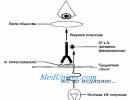Fundamental decision system (specific example). What is a homogeneous system of linear equations? An example of solving a homogeneous system of linear equations
2.4.1. Definition. Let us be given an inhomogeneous system of linear equations
Consider a homogeneous system
whose matrix of coefficients coincides with the matrix of coefficients of system (2.4.1). Then system (2.4.2) is called reduced homogeneous system (2.4.1).
2.4.2. Theorem. The general solution of an inhomogeneous system is equal to the sum of some particular solution of the inhomogeneous system and the general solution of the reduced homogeneous system.
Thus, to find a general solution to the inhomogeneous system (2.4.1) it is sufficient:
1) Research it for compatibility. In case of compatibility:
2) Find the general solution of the reduced homogeneous system.
3) Find any particular solution to the original (inhomogeneous) one.
4) By adding the found particular solution and the general solution of the given one, find the general solution of the original system.
2.4.3. Exercise. Investigate the system for compatibility and, in the case of compatibility, find its general solution in the form of the sum of the particular and the general given.
Solution. a) To solve the problem, we apply the above scheme:
1) We examine the system for compatibility (by the method of bordering minors): The rank of the main matrix is 3 (see the solution to Exercise 2.2.5, a), and the non-zero minor of the maximum order is composed of elements of the 1st, 2nd, 4th rows and 1st, 3 -th, 4th columns. To find the rank of the extended matrix, we border it with the 3rd row and 6th column of the extended matrix: =0. Means, rg A =rg=3, and the system is consistent. In particular, it is equivalent to the system
2) Let's find a general solution X 0 reduced homogeneous system
X 0 ={(-2a - b ; a ; b ; b ; b ) | a , b Î R}
(see solution to Exercise 2.2.5, a)).
3) Let us find any particular solution x h of the original system . To do this, in system (2.4.3), equivalent to the original one, the free unknowns x 2 and x We assume that 5 is equal to, for example, zero (this is the most convenient data):
and solve the resulting system: x 1 =- , x 3 =- , x 4 =-5. Thus, (- ; 0; - ; -5; 0) ¾ is a particular solution of the system.
4) Find the general solution X n of the original system :
X n={x h }+X 0 ={(- ; 0; - ; -5; 0)} + {(-2a - b ; a ; b ; b ; b )}=
={(- -2a - b ; a ; - + b ; -5+b ; b )}.
Comment. Compare the answer you received with the second answer in example 1.2.1 c). To obtain the answer in the first form for 1.2.1 c) the basic unknowns are taken x 1 , x 3 , x 5 (the minor for which is also not equal to zero), and as free ¾ x 2 and x 4 .
§3. Some applications.
3.1. On the issue of matrix equations. We remind you that matrix equation over the field F is an equation in which the unknown is a matrix over the field F .
The simplest matrix equations are equations of the form
AX=B , XA =B (2.5.1)
Where A , B ¾ given (known) matrix over a field F , A X ¾ such matrices, upon substitution of which equations (2.5.1) turn into true matrix equalities. In particular, the matrix method of certain systems is reduced to solving a matrix equation.
In the case when the matrices A in equations (2.5.1) are non-degenerate, they have solutions, respectively X =A B And X =B.A. .
In the case when at least one of the matrices on the left side of equations (2.5.1) is singular, this method is no longer suitable, since the corresponding inverse matrix A does not exist. In this case, finding solutions to equations (2.5.1) is reduced to solving systems.
But first, let's introduce some concepts.
Let us call the set of all solutions of the system general decision . Let us call a separately taken solution of an indefinite system private solution .
3.1.1. Example. Solve matrix equation over field R.
A) X = ; b) X = ; V) X = .
Solution. a) Since =0, then the formula X =A B is not suitable for solving this equation. If in the work XA =B matrix A has 2 rows, then the matrix X has 2 columns. Number of lines X must match the number of lines B . That's why X has 2 lines. Thus, X ¾ some square matrix of the second order: X = . Let's substitute X into the original equation:
Multiplying the matrices on the left side of (2.5.2), we arrive at the equality
Two matrices are equal if and only if they have the same dimensions and their corresponding elements are equal. Therefore (2.5.3) is equivalent to the system
This system is equivalent to the system
Solving it, for example, using the Gaussian method, we come to a set of solutions (5-2 b , b , -2d , d ), Where b , d run independently of each other R. Thus, X = .
b) Similar to a) we have X = and.
This system is inconsistent (check it out!). Therefore, this matrix equation has no solutions.
c) Let us denote this equation by AX =B . Because A has 3 columns and B has 2 columns, then X ¾ some matrix of dimension 3´2: X = . Therefore we have the following chain of equivalences:
We solve the last system using the Gaussian method (we omit comments)
Thus, we arrive at the system
whose solution is (11+8 z , 14+10z , z , -49+8w , -58+10w ,w ) Where z , w run independently of each other R.
Answer: a) X = , b , d Î R.
b) There are no solutions.
V) X = z , w Î R.
3.2. On the issue of permutability of matrices. In general, the product of matrices is non-commutable, that is, if A And B such that AB And B.A. are defined, then, generally speaking, AB ¹ B.A. . But an example of an identity matrix E shows that commutability is also possible A.E. =E.A. for any matrix A , if only A.E. And E.A. were determined.
In this section we will consider problems of finding the set of all matrices that commute with a given one. Thus,
Unknown x 1 , y 2 and z 3 can take any value: x 1 =a , y 2 =b , z 3 =g . Then
Thus, X = .
Answer. A) X d ¾ any number.
b) X ¾ set of matrices of the form , where a , b And g ¾ any numbers.
You can order a detailed solution to your problem!!!To understand what it is fundamental decision system you can watch a video tutorial for the same example by clicking. Now let's move on to the actual description of all the necessary work. This will help you understand the essence of this issue in more detail.
How to find the fundamental system of solutions to a linear equation?
Let's take for example the following system of linear equations:
Let's find the solution to this linear system of equations. To begin with, we you need to write out the coefficient matrix of the system.
Let's transform this matrix to a triangular one. We rewrite the first line without changes. And all the elements that are under $a_(11)$ must be made zeros. To make a zero in place of the element $a_(21)$, you need to subtract the first from the second line, and write the difference in the second line. To make a zero in place of the element $a_(31)$, you need to subtract the first from the third line and write the difference in the third line. To make a zero in place of the element $a_(41)$, you need to subtract the first multiplied by 2 from the fourth line and write the difference in the fourth line. To make a zero in place of the element $a_(31)$, you need to subtract the first multiplied by 2 from the fifth line and write the difference in the fifth line. 
We rewrite the first and second lines without changes. And all the elements that are under $a_(22)$ must be made zeros. To make a zero in place of the element $a_(32)$, you need to subtract the second one multiplied by 2 from the third line and write the difference in the third line. To make a zero in place of the element $a_(42)$, you need to subtract the second multiplied by 2 from the fourth line and write the difference in the fourth line. To make a zero in place of the element $a_(52)$, you need to subtract the second multiplied by 3 from the fifth line and write the difference in the fifth line. 
We see that the last three lines are the same, so if you subtract the third from the fourth and fifth, they will become zero. 
According to this matrix write a new system of equations.
We see that we have only three linearly independent equations, and five unknowns, so the fundamental system of solutions will consist of two vectors. So we we need to move the last two unknowns to the right.
Now, we begin to express those unknowns that are on the left side through those that are on the right side. We start with the last equation, first we express $x_3$, then we substitute the resulting result into the second equation and express $x_2$, and then into the first equation and here we express $x_1$. Thus, we expressed all the unknowns that are on the left side through the unknowns that are on the right side. 
Then, instead of $x_4$ and $x_5$, we can substitute any numbers and find $x_1$, $x_2$ and $x_3$. Each five of these numbers will be the roots of our original system of equations. To find the vectors that are included in FSR we need to substitute 1 instead of $x_4$, and substitute 0 instead of $x_5$, find $x_1$, $x_2$ and $x_3$, and then vice versa $x_4=0$ and $x_5=1$.
Purpose of the service. The online calculator is designed to find a non-trivial and fundamental solution to the SLAE. The resulting solution is saved in a Word file (see example solution).
Instructions. Select matrix dimension:
Properties of systems of linear homogeneous equations
In order for the system to have non-trivial solutions, it is necessary and sufficient that the rank of its matrix be less than the number of unknowns.Theorem. A system in the case m=n has a nontrivial solution if and only if the determinant of this system is equal to zero.
Theorem. Any linear combination of solutions to a system is also a solution to that system.
Definition. The set of solutions to a system of linear homogeneous equations is called fundamental system of solutions, if this set consists of linearly independent solutions and any solution to the system is a linear combination of these solutions.
Theorem. If the rank r of the system matrix is less than the number n of unknowns, then there exists a fundamental system of solutions consisting of (n-r) solutions.
Algorithm for solving systems of linear homogeneous equations
- Finding the rank of the matrix.
- We select the basic minor. We distinguish dependent (basic) and free unknowns.
- We cross out those equations of the system whose coefficients are not included in the basis minor, since they are consequences of the others (according to the theorem on the basis minor).
- We move the terms of the equations containing free unknowns to the right side. As a result, we obtain a system of r equations with r unknowns, equivalent to the given one, the determinant of which is nonzero.
- We solve the resulting system by eliminating unknowns. We find relationships expressing dependent variables through free ones.
- If the rank of the matrix is not equal to the number of variables, then we find the fundamental solution of the system.
- In the case rang = n we have a trivial solution.
Example. Find the basis of the system of vectors (a 1, a 2,...,a m), rank and express the vectors based on the base. If a 1 =(0,0,1,-1), and 2 =(1,1,2,0), and 3 =(1,1,1,1), and 4 =(3,2,1 ,4), and 5 =(2,1,0,3).
Let's write down the main matrix of the system:
Multiply the 3rd line by (-3). Let's add the 4th line to the 3rd:
| 0 | 0 | 1 | -1 |
| 0 | 0 | -1 | 1 |
| 0 | -1 | -2 | 1 |
| 3 | 2 | 1 | 4 |
| 2 | 1 | 0 | 3 |
Multiply the 4th line by (-2). Let's multiply the 5th line by (3). Let's add the 5th line to the 4th:
Let's add the 2nd line to the 1st:
Let's find the rank of the matrix.
The system with the coefficients of this matrix is equivalent to the original system and has the form:
- x 3 = - x 4
- x 2 - 2x 3 = - x 4
2x 1 + x 2 = - 3x 4
Using the method of eliminating unknowns, we find a nontrivial solution:
We obtained relations expressing the dependent variables x 1 , x 2 , x 3 through the free ones x 4 , that is, we found a general solution:
x 3 = x 4
x 2 = - x 4
x 1 = - x 4
The Gaussian method has a number of disadvantages: it is impossible to know whether the system is consistent or not until all the transformations necessary in the Gaussian method have been carried out; Gauss's method is not suitable for systems with letter coefficients.
Let's consider other methods for solving systems of linear equations. These methods use the concept of matrix rank and reduce the solution of any consistent system to the solution of a system to which Cramer's rule applies.
Example 1. Find a general solution to the following system of linear equations using the fundamental system of solutions to the reduced homogeneous system and a particular solution to the inhomogeneous system.
1. Making a matrix A and extended system matrix (1)


2. Explore the system (1) for togetherness. To do this, we find the ranks of the matrices A and https://pandia.ru/text/78/176/images/image006_90.gif" width="17" height="26 src=">). If it turns out that , then the system (1) incompatible. If we get that , then this system is consistent and we will solve it. (The compatibility study is based on the Kronecker-Capelli theorem).
a. We find rA.
To find rA, we will consider sequentially non-zero minors of the first, second, etc. orders of the matrix A and the minors surrounding them.
M1=1≠0 (we take 1 from the upper left corner of the matrix A).
We border M1 the second row and second column of this matrix.  . We continue to border M1 the second line and the third column..gif" width="37" height="20 src=">. Now we border the non-zero minor M2′ second order.
. We continue to border M1 the second line and the third column..gif" width="37" height="20 src=">. Now we border the non-zero minor M2′ second order.
We have:  (since the first two columns are the same)
(since the first two columns are the same)
 (since the second and third lines are proportional).
(since the second and third lines are proportional).
We see that rA=2, a is the basis minor of the matrix A.
b. We find.
Fairly basic minor M2′ matrices A border with a column of free terms and all rows (we have only the last row).
 . It follows that M3′′ remains the basic minor of the matrix https://pandia.ru/text/78/176/images/image019_33.gif" width="168 height=75" height="75"> (2)
. It follows that M3′′ remains the basic minor of the matrix https://pandia.ru/text/78/176/images/image019_33.gif" width="168 height=75" height="75"> (2)
Because M2′- basis minor of the matrix A systems (2) , then this system is equivalent to the system (3) , consisting of the first two equations of the system (2) (for M2′ is in the first two rows of matrix A).
 (3)
(3)
Since the basic minor https://pandia.ru/text/78/176/images/image021_29.gif" width="153" height="51"> (4)
In this system there are two free unknowns ( x2 And x4 ). That's why FSR systems (4) consists of two solutions. To find them, we assign free unknowns in (4) values first x2=1 , x4=0 , and then - x2=0 , x4=1 .
At x2=1 , x4=0 we get:
 .
.
This system already has the only thing solution (it can be found using Cramer's rule or any other method). Subtracting the first from the second equation, we get:
Her solution will be x1= -1 , x3=0 . Given the values x2 And x4 , which we added, we obtain the first fundamental solution of the system (2) : .
Now we believe in (4) x2=0 , x4=1 . We get:
 .
.
We solve this system using Cramer’s theorem:

 .
.
We obtain the second fundamental solution of the system (2) : .
Solutions β1 , β2 and make up FSR systems (2) . Then its general solution will be
γ= C1 β1+С2β2=С1(‑1, 1, 0, 0)+С2(5, 0, 4, 1)=(‑С1+5С2, С1, 4С2, С2)
Here C1 , C2 – arbitrary constants.
4. Let's find one private solution heterogeneous system(1) . As in paragraph 3 , instead of the system (1) Let's consider an equivalent system (5) , consisting of the first two equations of the system (1) .
 (5)
(5)
Let us move the free unknowns to the right sides x2 And x4.
 (6)
(6)
Let's give free unknowns x2 And x4 arbitrary values, for example, x2=2 , x4=1 and put them in (6) . Let's get the system

This system has a unique solution (since its determinant M2′0). Solving it (using Cramer’s theorem or Gauss’s method), we obtain x1=3 , x3=3 . Given the values of the free unknowns x2 And x4 , we get particular solution of an inhomogeneous system(1)α1=(3,2,3,1).
5. Now all that remains is to write it down general solution α of an inhomogeneous system(1) : it is equal to the sum private solution this system and general solution of its reduced homogeneous system (2) :
α=α1+γ=(3, 2, 3, 1)+(‑С1+5С2, С1, 4С2, С2).
This means:  (7)
(7)
6. Examination. To check if you solved the system correctly (1) , we need a general solution (7) substitute in (1) . If each equation turns into the identity ( C1 And C2 must be destroyed), then the solution is found correctly.
We'll substitute (7) for example, only the last equation of the system (1) (x1 + x2 + x3 ‑9 x4 =‑1) .
We get: (3–С1+5С2)+(2+С1)+(3+4С2)–9(1+С2)=–1
(С1–С1)+(5С2+4С2–9С2)+(3+2+3–9)=–1
Where –1=–1. We got an identity. We do this with all the other equations of the system (1) .
Comment. The check is usually quite cumbersome. The following “partial check” can be recommended: in the general solution of the system (1) assign some values to arbitrary constants and substitute the resulting partial solution only into the discarded equations (i.e., into those equations from (1) , which were not included in (5) ). If you get identities, then more likely, system solution (1) found correctly (but such a check does not provide a complete guarantee of correctness!). For example, if in (7) put C2=- 1 , C1=1, then we get: x1=-3, x2=3, x3=-1, x4=0. Substituting into the last equation of system (1), we have: - 3+3 - 1 - 9∙0= - 1 , i.e. –1=–1. We got an identity.
Example 2. Find a general solution to a system of linear equations (1) , expressing the basic unknowns in terms of free ones.
Solution. As in example 1, compose matrices A and https://pandia.ru/text/78/176/images/image010_57.gif" width="156" height="50"> of these matrices. Now we leave only those equations of the system (1) , the coefficients of which are included in this basic minor (i.e., we have the first two equations) and consider a system consisting of them, equivalent to system (1).
Let us transfer the free unknowns to the right-hand sides of these equations.
system (9) We solve by the Gaussian method, considering the right-hand sides as free terms.
https://pandia.ru/text/78/176/images/image035_21.gif" width="202 height=106" height="106">

Option 2.

https://pandia.ru/text/78/176/images/image039_16.gif" width="192" height="106 src=">

Option 4.
https://pandia.ru/text/78/176/images/image042_14.gif" width="172" height="80">
Option 5.
https://pandia.ru/text/78/176/images/image044_12.gif" width="179 height=106" height="106">
Option 6.
https://pandia.ru/text/78/176/images/image046_11.gif" width="195" height="106">
Homogeneous systems of linear algebraic equations
As part of the lessons Gaussian method And Incompatible systems/systems with a common solution we considered inhomogeneous systems of linear equations, Where free member(which is usually on the right) at least one from the equations was different from zero.
And now, after a good warm-up with matrix rank, we will continue to polish the technique elementary transformations on homogeneous system of linear equations.
Based on the first paragraphs, the material may seem boring and mediocre, but this impression is deceptive. In addition to further development of techniques, there will be a lot of new information, so please try not to neglect the examples in this article.
What is a homogeneous system of linear equations?
The answer suggests itself. A system of linear equations is homogeneous if the free term everyone equation of the system is zero. For example:
It is absolutely clear that a homogeneous system is always consistent, that is, it always has a solution. And, first of all, what catches your eye is the so-called trivial solution ![]() . Trivial, for those who do not understand the meaning of the adjective at all, means without a show-off. Not academically, of course, but intelligibly =) ...Why beat around the bush, let's find out if this system has any other solutions:
. Trivial, for those who do not understand the meaning of the adjective at all, means without a show-off. Not academically, of course, but intelligibly =) ...Why beat around the bush, let's find out if this system has any other solutions:
Example 1
Solution: to solve a homogeneous system it is necessary to write system matrix and with the help of elementary transformations bring it to a stepwise form. Please note that here there is no need to write down the vertical bar and the zero column of free terms - after all, no matter what you do with zeros, they will remain zeros: 
(1) The first line was added to the second line, multiplied by –2. The first line was added to the third line, multiplied by –3.
(2) The second line was added to the third line, multiplied by –1.
Dividing the third line by 3 doesn't make much sense.
As a result of elementary transformations, an equivalent homogeneous system is obtained  , and, using the inverse of the Gaussian method, it is easy to verify that the solution is unique.
, and, using the inverse of the Gaussian method, it is easy to verify that the solution is unique.
Answer: ![]()
Let us formulate an obvious criterion: a homogeneous system of linear equations has just a trivial solution, If system matrix rank(in this case 3) is equal to the number of variables (in this case – 3 pieces).
Let's warm up and tune our radio to the wave of elementary transformations:
Example 2
Solve a homogeneous system of linear equations 
From the article How to find the rank of a matrix? Let us recall the rational technique of simultaneously decreasing the matrix numbers. Otherwise, you will have to cut large, and often biting fish. An approximate example of a task at the end of the lesson.
Zeros are good and convenient, but in practice the case is much more common when the rows of the system matrix linearly dependent. And then the emergence of a general solution is inevitable:
Example 3
Solve a homogeneous system of linear equations 
Solution: let’s write down the matrix of the system and, using elementary transformations, bring it to a stepwise form. The first action is aimed not only at obtaining a single value, but also at decreasing the numbers in the first column:
(1) A third line was added to the first line, multiplied by –1. The third line was added to the second line, multiplied by –2. At the top left I got a unit with a “minus”, which is often much more convenient for further transformations.
(2) The first two lines are the same, one of them was deleted. Honestly, I didn’t push the solution - it turned out that way. If you perform transformations in a template manner, then linear dependence lines would have been revealed a little later.
(3) The second line was added to the third line, multiplied by 3.
(4) The sign of the first line was changed.
As a result of elementary transformations, an equivalent system was obtained: 
The algorithm works exactly the same as for heterogeneous systems. The variables “sitting on the steps” are the main ones, the variable that did not get a “step” is free.
Let's express the basic variables through a free variable: 
Answer: common decision: ![]()
The trivial solution is included in the general formula, and it is unnecessary to write it down separately.
The check is also carried out according to the usual scheme: the resulting general solution must be substituted into the left side of each equation of the system and a legal zero must be obtained for all substitutions.
It would be possible to finish this quietly and peacefully, but the solution to a homogeneous system of equations often needs to be represented in vector form by using fundamental system of solutions. Please forget about it for now analytical geometry, since now we will talk about vectors in the general algebraic sense, which I opened a little in the article about matrix rank. There is no need to gloss over the terminology, everything is quite simple.






